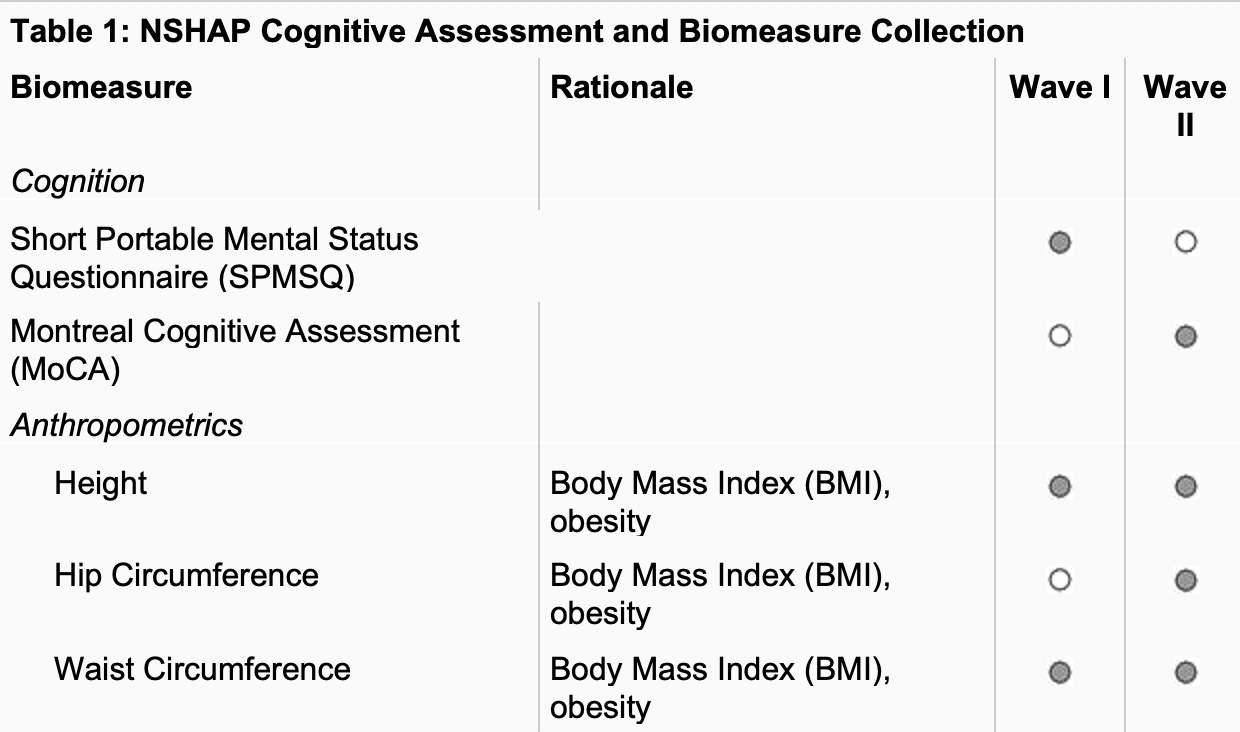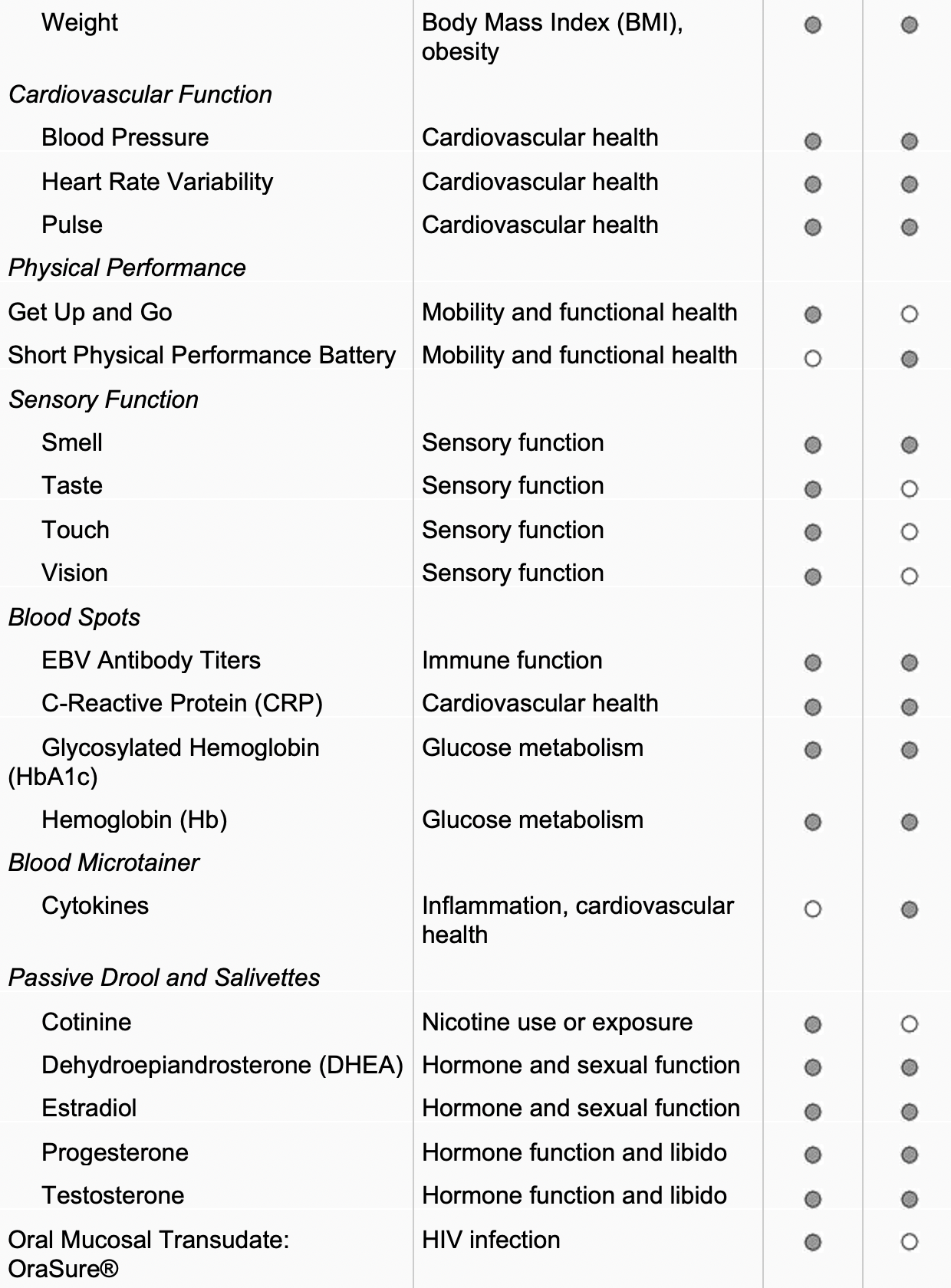http://www.norc.org/Research/Projects/Pages/national-social-life-health-and-aging-project.aspx
Overview
The National Social Life, Health, and Aging Project (NSHAP) establishes longitudinal, population-based data on health, sexuality and social life among older Americans. NSHAP examines the role of relationships in healthy aging through the collection of high-quality data on social networks; marital, cohabitating and sexual partnerships; attitudes and self-reported behavior; social support; and cutting-edge biomarkers of physical function and health. Additionally, the project fills a crucial gap in knowledge about the health trajectories of older adults and informs new approaches to reducing morbidity and preventing disability and dysfunction as individuals age.
Data Collection
NSHAP Wave I used a national area probability sample of community-residing adults ages 57 to 85 at the time of the interview with an oversampling of African-American and Hispanic areas. Between July of 2005 and March of 2006, NORC and the investigator team at the University of Chicago completed 3,005 interviews with Wave I respondents for an overall weighted response rate of 75.5 percent. Wave II supplemented data from Wave I with the Partner Study, which obtained data from Wave I respondents’ romantic partners, with 3,377 interviews (2,261 follow-up; 161 New Cohort). Beginning in August of 2010, NSHAP returned to Referent Respondents and, in addition, interviewed Referent Respondents’ Current Partners. From 2015 to 2016, Wave III was completed with 4,777 interviews (2,409 follow-up; 2,368 New Cohort) from the respondents and their partners.
As before, NSHAP data collection consists of three distinct components: 1) an in-person questionnaire; 2) biomeasure collection; and 3) a paper leave-behind questionnaire. The in-person questionnaire and biomeasures were administered by a NORC field interviewer in the respondent’s home. Questionnaire topics included: demographic characteristics; social networks; social and cultural activity; physical and mental health including cognition; well-being; illness; medications; history of sexual and intimate partnerships; and patient-physician communication. Additionally, a number of biomeasures were collected in NSHAP Wave I: height; weight; waist circumference; blood pressure; smell; taste; vision; touch; respondent-administered vaginal swabs; oral mucosal transudate (OMT) for HIV-1 antibody screening; saliva; ‘get up and go’; and dried blood spots.
Biomarkers
All biomeasures were chosen within the purview of feasibility and acceptability to both interviewers and respondents. Biomeasures were selected to assess: physical function and condition; presence of disease or risk; sensory function; endocrine function, immune function; and health behaviors. All biomeasures included in NSHAP were specifically designed to be implemented by non-medically trained interviewers.
Wave I
A number of biomeasures were collected in NSHAP Wave I: height; weight; waist circumference; blood pressure; smell; taste; vision; touch; respondent-administered vaginal swabs; oral mucosal transudate (OMT) for HIV-1 antibody screening; saliva; ‘get up and go’; and blood spots. Technological advances in biomeasure collection methods have decreased respondent burden and increased ease of collection, storage, and yield of various biomeasures for the second wave of NSHA.
Wave II
In Wave II, biomeasures collected include: anthropometrics, including height, hip and waist circumference, and weight; cardiovascular function, including blood pressure, heart rate variability, and pulse; 2 of the 3 components of the short physical performance battery (SPPB) including chair stands and a timed walk; sensory function including smell; and actigraphy. In addition, ried blood spots, microtainer blood, passive drool and salivettes, urine, and respondent-administered vaginal swabs were collected, each of which are analyzed using multiple assays for a variety of measures and rationales. Furthermore, respondents’ cognition using the Montreal Cognitive Assessment (MoCA) was assessed.
Wave III
In Wave III, biomeasures collected include: anthropometrics, including height (new cohort only), hip and waist circumference (new cohort only), and weight; cardiovascular function, including blood pressure, heart rate variability, and pulse; 2 of the 3 components of the short physical performance battery (SPPB) including chair stands and a timed walk; sensory function including smell; and saliva and medication log (saliva – new cohort only).


